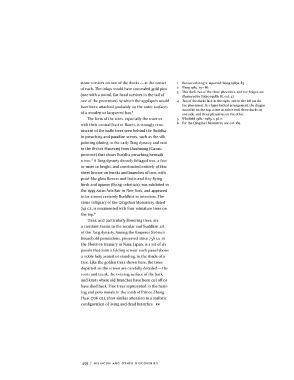Page 460 - The Golden Age of Chinese Archaeology: Celebrated Discoveries from the People’s Republic of China
P. 460
stone survives on one of the ducks — at the center 1 Recovered in 1971; reported: Wang 19893, 83.
of each. The inlays would have concealed gold pins 2 Wang 1989, 79 - 86.
3 This duck, two of the three phoenixes, and the dragon are
(one with a round, flat head survives in the tail of illustrated in Tokyo 1998!}, 87, cat. 47.
one of the phoenixes) by which the appliques would 4 Two of the ducks face to the right, one to the left (as do
have been attached, probably on the outer surfaces the phoenixes). In a hypothetical arrangement, the dragon
of a wooden or lacquered box. 4 would be on the top, a tree at either end, three ducks on
one side, and three phoenixes on the
other.
The form of the trees, especially the rosettes 5 Whitfield 1982 -1985, i: pi. 7.
with their central fruit or flower, is strongly remi- 6 For the Qingshan Monastery, see cat. 169.
niscent of the bodhi trees seen behind the Buddha
in preaching and paradise scenes, such as the silk
painting (dating to the early Tang dynasty and now
in the British Museum) from Dunhuang (Gansu
province) that shows Buddha preaching beneath
5
a tree. A Tang dynasty densely foliaged tree, a foot
or more in height, and constructed entirely of thin
sheet bronze on trunks and branches of iron, with
pearl-like glass flowers and fruits and tiny flying
birds and apsams (flying celestials), was exhibited in
the 1999 Asian Arts Fair in New York, and appeared
to be almost certainly Buddhist in intention. The
stone reliquary of the Qingshan Monastery, dated
741 CE, is ornamented with four miniature trees on
the top. 6
Trees, and particularly flowering trees, are
a constant theme in the secular and Buddhist art
of the Tang dynasty. Among the Emperor Shomu's
household possessions, preserved since 756 CE in
the Shoso-in treasury in Nara, Japan, is a set of six
panels that form a folding screen: each panel shows
a noble lady, seated or standing, in the shade of a
tree. Like the golden trees shown here, the trees
depicted on the screen are carefully detailed — the
roots and trunk, the twisting surface of the bark,
and knots where old branches have been cut off or
have died back. Pine trees represented in the hunt-
ing and polo murals in the tomb of Prince Zhang
Huai (706 CE), show similar attention to a realistic
configuration of living and dead branches. RW
459 | H E J I A C U N AND O T H E R D I S C O V E R I E S

